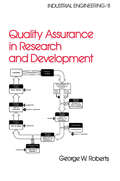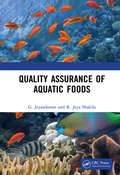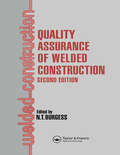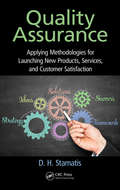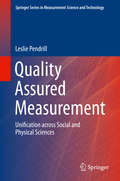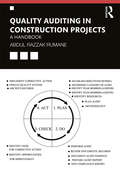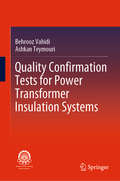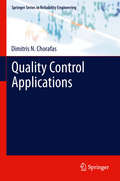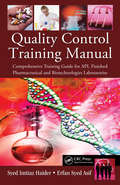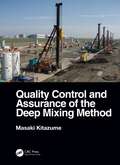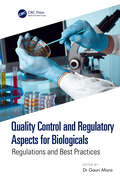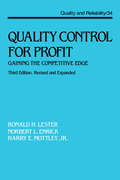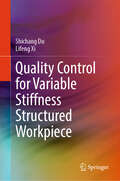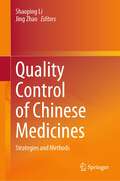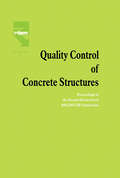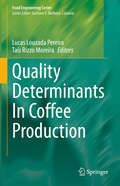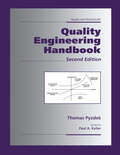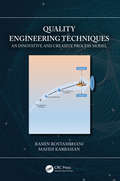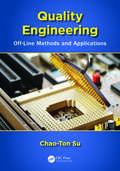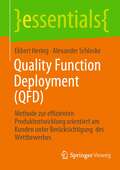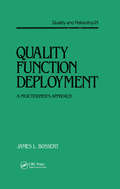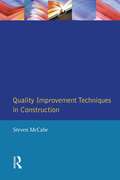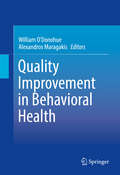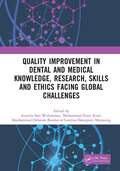- Table View
- List View
Quality Assurance in Research and Development (Industrial Engineering: A Series of Reference Books and Textboo)
by George W. RobertsThis book provides guidelines for obtaining research and development (RD) results of a consistent and known quality. The approaches discussed here have been developed for an industrial research center engaged in RD to support operating divisions of the parent corporation.
Quality Assurance of Aquatic Foods
by G. Jeyasekaran R. Jeya ShakilaThis book deals with the quality and safety of aquatic food. It focuses clearly on biological and chemical hazards, antibiotic and pesticide residues, and heavy metal contaminants associated with aquatic food. The quality problems in various aquatic food products and their methods of assessment are exhaustively dealt in this book. Besides, food quality management systems like HACCP, SSOP, SCP, GHP, GMP have also been explained for easy adoption. The International and National Standards prescribed by FSSAI, EIC, BIS, Codex, USFDA, ISO and EU for aquatic food products are explicitly given. It is also useful to the personnel of aquatic food industries to improve their working knowledge on maintaining the quality and safety aquatic foods. Note: T& F does not sell or distribute the Hardback in India, Pakistan, Nepal, Bhutan, Bangladesh and Sri Lanka.
Quality Assurance of Welded Construction
by N. T. BurgessSince the first edition of this book was published, most developments in welding construction have been within the quality assurance element of the process rather than in welding technology itself.The continuous pressures from worldwide clients seeking better reliability from welded structures has focused much attention on to quality.The quality ch
Quality Assurance: Applying Methodologies for Launching New Products, Services, and Customer Satisfaction (Practical Quality Of The Future Ser.)
by D. H. StamatisAlthough regularly introducing new products or services is the lifeblood of most industries, bringing them to market can be fraught with peril. Timing, cost, and quality all play important roles in a successful product launch and avoiding expensive- often in more than just dollars- recalls and redesigns. Quality Assurance: Applying Methodologies fo
Quality Assured Measurement: Unification across Social and Physical Sciences (Springer Series in Measurement Science and Technology)
by Leslie PendrillThis book presents a general and comprehensive framework for the assurance of quality in measurements. Written by a foremost expert in the field, the text reflects an on-going international effort to extend traditional quality assured measurement, rooted in fundamental physics and the SI, to include non-physical areas such as person-centred care and the social sciences more generally. Chapter by chapter, the book follows the measurement quality assurance loop, based on Deming’s work. The author enhances this quality assurance cycle with insights from recent research, including work on the politics and philosophy of metrology, the new SI, quantitative and qualitative scales and entropy, decision risks and uncertainty when addressing human challenges, Man as a Measurement Instrument, and Psychometry and Person-centred care. Quality Assured Measurement: Unification across Social and Physical Sciences provides students and researchers in physics, chemistry, engineering, medicine and the social sciences with practical guidance on designing, implementing and applying a quality-assured measurement while engaging readers in the most novel and expansive areas of contemporary measurement research.
Quality Auditing in Construction Projects: A Handbook
by Abdul Razzak RumaneThis book provides construction professionals, designers, contractors and quality auditors involved in construction projects with the auditing skills and processes required to improve construction quality and make their projects more competitive and economical. The processes within the book focus on auditing compliance to ISO, corporate quality management systems, project specific quality management systems, contract management, regulatory authorities’ requirements, safety, and environmental considerations. The book is divided into seven chapters and each chapter is divided into numbered sections covering auditing-related topics that have importance or relevance for understanding quality auditing concepts for construction projects. No other book covers construction quality auditing in such detail and with this level of practical application. It is an essential guide for construction and quality professionals, but also for students and academics interested in learning about quality auditing in construction projects.
Quality Beyond Six Sigma: A Lean Approach To Building Sustainable Quality Beyond Six Sigma
by Ron Basu Nevan WrightSix Sigma is a data-driven management system with near-perfect performance that is a statistical target of operating with no more that 3.4 defects per one million chances. Six sigma has both created avid interest and raised concerns among executives and its practioners. This is all very well for multinationals like Motorola or General Electric but how can it help small and medium-sized enterprises or the service industry? How do you ensure that solutions stick? Quality Beyond Six Sigma responds to this challenge and provides a practical implementation of the issues of Six Sigma, Lean Enterprise and Total Quality and aligns the 'hard' sigma message with the softer sustainable 'strategic issues'. The result is FIT SIGMA.The authors utilize major and minor case studies to support principles and learnings of FIT SIGMA and include review examples and self-assessment that underpin the sustainable process. The three major case studies are contributed by General Electric, Dow Chemical and Seagate Technology.Senior Executives and Managers of organizations of all types and sizes, Management Consultants and Students of all disciplines will find this book a stimulating guide to quality and operational excellence.
Quality Confirmation Tests for Power Transformer Insulation Systems
by Behrooz Vahidi Ashkan TeymouriThis book focuses on oil-paper insulation included in power transformers, especially for EHV and UHV transformers. The importance on insulation ever increased due to a growing voltage rating of transformers. Within the last decades, although research on the transformer insulation and diagnosis methods has advanced a lot, the insulation of HV transformers remained more or less unchanged. The book is divided into five chapters; the first and second chapters explain the basics of oil insulation, while the third chapter focuses on paper insulation. The final two chapters deal with the methods and outcome of testing both techniques. The primary target audience for this book is graduate students and power system engineers.
Quality Control Applications
by Dimitris N. ChorafasQuality control is a constant priority in electrical, mechanical, aeronautical, and nuclear engineering - as well as in the vast domain of electronics, from home appliances to computers and telecommunications. Quality Control Applications provides guidance and valuable insight into quality control policies; their methods, their implementation, constant observation and associated technical audits. What has previously been a mostly mathematical topic is translated here for engineers concerned with the practical implementation of quality control. Once the fundamentals of quality control are established, Quality Control Applications goes on to develop this knowledge and explain how to apply it in the most effective way. Techniques are described and supported using relevant, real-life, case studies to provide detail and clarity for those without a mathematical background. Among the many practical examples, two case studies dramatize the importance of quality assurance: A shot-by-shot analysis of the errors made in the Fukushima Daiichi nuclear disaster; and the engineering failure with new technology due to the absence of quality control in an alternative energy project. This clear and comprehensive approach makes Quality Control Applications an essential reference for those studying engineering as well industry professionals involved in quality control across product and system design.
Quality Control Training Manual: Comprehensive Training Guide for API, Finished Pharmaceutical and Biotechnologies Laboratories
by Syed Imtiaz Haider Syed Erfan AsifWritten to help companies comply with GMP, GLP, and validation requirements imposed by the FDA and regulatory bodies worldwide, Quality Control Training Manual: Comprehensive Training Guide for API, Finished Pharmaceutical and Biotechnologies Laboratories presents cost-effective training courses that cover how to apply advances in the life sciences to produce commercially viable biotech products and services in terms of quality, safety, and efficacy. This book and its accompanying downloadable resources comprise detailed text, summaries, test papers, and answers to test papers, providing an administrative solution for management. Provides the FDA, Health Canada, WHO, and EMEA guidelines directly applicable to pharmaceutical laboratory-related issues Offers generic formats and styles that can be customized to any organization and help management build quality into routine operations to comply with regulatory requirements Contains ready-to-use training courses that supply a good source of training material for experienced and inexperienced practitioners in the biotechnology/biopharmaceutical industries Includes downloadable resources with downloadable training courses that can be adopted and directly customized to a particular organization Supplies ready-to-use test papers that allow end users to record all raw data up to the issuance of the attached certificate The biotechnology/bioscience industries are regulated worldwide to be in compliance with cGMP and GLP principles, with particular focus on safety issues. Each company must create a definite training matrix of its employees. The training procedures in this book enable end users to understand the principles and elements of manufacturing techniques and provide documentation language ranging from the generic to the specific. The training courses on the downloadable resources supply valuable tools for developing training matrices to achieve FDA, Health Canada, EMEA, MHRA UK, WHO, and GLP compliance.
Quality Control and Assurance of the Deep Mixing Method
by Masaki KitazumeThe deep mixing (DM) method developed in Japan and Sweden in the 1970s has gained popularity worldwide. The DM-improved ground is a composite system comprising stiff stabilized soil and unstabilized soft soil, which necessitates geotechnical engineers to fully understand the interaction of stabilized and unstabilized soils and the engineering characteristics of in-situ stabilized soil. The success of the DM project cannot be achieved by the well-determined geotechnical design alone but is guaranteed only when the quality and geometric layout envisaged in the design is realized in the field with an acceptable level of accuracy. The process design, production with careful quality control and quality assurance are the key issues in the DM project. This book is intended to provide the state of the art and practice of quality control and assurance on deep mixing in detail based on the experience and research efforts accumulated in the past 50 years.
Quality Control and Regulatory Aspects for Biologicals: Regulations and Best Practices
by Gauri MisraThis book serves as a comprehensive guide on quality control and regulatory aspects for biological products. It covers a wide range of topics, including regulatory requirements, quality control strategies, analytical methods, and risk management. It delves into the advantages and limitations of in vivo tests and discusses alternative methods that can be employed. The book explores the use of animal-based testing methods in quality control and examines viable alternatives.Key Features: Reviews various scientific and regulatory aspects involved in the quality control of biologicals Provides an overview of the roles of various national and international regulatory bodies and accreditation agencies Presents advanced analytical methods, innovative technologies, and the integration of molecular diagnostics in quality control processes Explores the use of animal-based testing methods in quality control, as well as their alternatives Discusses guidelines and methodologies involved in the development of biological products Overall, this book is an important reference source for various professionals in the pharmaceutical industry, including researchers, scientists, quality control personnel, and regulatory affairs professionals.
Quality Control for Profit: Gaining the Competitive Edge, Third Edition, (Quality and Reliability)
by Ronald H. Lester Norbert L. Enrick Harry E. Mottley Jr.This book focuses on practical proven programs that have enabled companies to gain a worldwide competitive edge. The blending of total quality control with total employee involvement and just-in-time manufacturing concepts provides the means for gaining the competitive edge.
Quality Control for Variable Stiffness Structured Workpiece
by Shichang Du Lifeng XiThis book investigates quality control methods for variable stiffness structured workpiece. With the development of modern manufacturing industries, more and more workpieces with complex geometries are being designed and manufactured. The definition of variable stiffness structured workpieces includes three key features: multiple geometrical features, multiple geometrical tolerance constraints, and multistage manufacturing processes (denoted as 3M features). The variable stiffness structured workpieces have multiple geometrical features (planar surfaces, cylindrical surfaces, cone surfaces, sphere surfaces, freeform surfaces, etc.) with multiple geometric tolerance constraints (flatness, waviness, roughness, roundness, cylindrical degree, etc.) and are manufactured by multiple manufacturing processes. The 3M features of variable stiffness structured workpieces bring challenges for products&’ quality evaluation and quality control. The quality propagation of multiple quality characteristics through multiple manufacturing processes is complicated. The multiscale geometrical specifications influence the final functions of products in different ways. And the varied stiffness problem brought by complex geometry structure of the workpieces also makes the manufactured surface quality hard to control. The book is intended for undergraduate, graduate students, and researchers who are interested in developments of quality control methods and applications.
Quality Control of Chinese Medicines: Strategies and Methods
by Jing Zhao Shaoping LiThis book focuses on the strategies and methods for quality control of Chinese medicines used in prevention and treatment of diseases for thousands of years in China and East Asia. It explains various strategies and methods for quality markers discovery and herbal glycoanalysis, as well as practices for control of heavy metal and pesticide residues. Strategies to overcome the shortage of reference compounds for quality control of Chinese medicines are also provided. The book also introduces analytical techniques for different analytes in Chinese medicines with an emphasis on sample preparation in automation and high extraction efficiency methods, the key process affecting the time and accuracy of the techniques. It is of interest to quality control scientists in academia and industry working on Chinese medicines and/or herbal medicine and also pharmacists, pharmacologists, food chemists, and nutritionists who want to understand Chinese medicines.
Quality Control of Concrete Structures: Proceedings of the Second International RILEM/CEB Symposium
by L. Taerwe H. LambotteThis book details the latest information on the applied methods and techniques being used for quality control of concrete construction worldwide. The book forms the proceedings of the Second International Symposium on Quality Control on Concrete Structures, held in Belgium, June 1991.
Quality Determinants In Coffee Production (Food Engineering Series)
by Lucas Louzada Pereira Taís Rizzo MoreiraQuality Determinants In Coffee Production presents a comprehensive overview of the main determinants of coffee quality during processing. Authored by members of the Laboratory for Analysis and Research in Coffee at the Federal Institute of Espírito Santo, the chapters in this text explain how coffee quality can be affected through each step of the main processing methods. The first section explores the history of coffee processing, covering how the processes and techniques of sensorial analysis have developed. The second section covers the evolution of these techniques and how various complexities can affect their use, plus the statistical tools that are used to increase test accuracy. Another section focuses on the relationship between fruit microbiology and coffee quality, promoting an understanding of how yeasts, fungi and bacteria effect the quality of coffee during processing. Another section is dedicated to the biotechnological processes used in coffee production, including the applicability of induced and spontaneous routes from the manipulation of raw material, the relationship between wet processing and spontaneous fermentation and the construction of sensorial routes. A final section explores volatile coffee compounds and gas chromatography techniques, including chemical and sensory maps. The majority of the reference works published on coffee processing have a pragmatic approach covering production, harvesting, post-harvesting and marketing. This work goes beyond these subjects, covering the factors that impact quality and how they lead to either qualitative reduction or gains during processing. New technological and scientific indicators for the modification and the creation of sensory routes are extensively covered, as are the international protocols used in the sensorial analysis of coffee. With its broad approach, this text presents a multidisciplinary perspective connecting areas such as statistics, biochemistry, analytical chemistry and microbiology to the results of sensory analysis using different technologies and processes. A direct relationship between these factors is established in order to help researchers understand their combined effect on coffee quality during processing.
Quality Engineering Handbook (Quality and Reliability)
by Thomas Pyzdek Paul A. KellerWritten by one of the foremost authorities on the subject, the Second Edition is completely revised to reflect the latest changes to the ASQ Body of Knowledge for the Certified Quality Engineer (CQE). This handbook covers every essential topic required by the quality engineer for day-to-day practices in planning, testing, finance, and management an
Quality Engineering Techniques: An Innovative and Creative Process Model
by Ramin Rostamkhani Mahdi KarbasianIn today’s industrial and complex world, the progress of change is incredible. The amount of information which needs to be analyzed is very large and time has become more and more limited. Industries and firms of all sizes desire to increase productivity and sustainability to keep their competitive edge in the marketplace. One of the best tools for achieving this is the application of Quality Engineering Techniques (QET). This book will introduce the integrated model and the numerical applications for implementing it.
Quality Engineering: Off-Line Methods and Applications
by Chao-Ton SuAs quality becomes an increasingly essential factor for achieving business success, building quality improvement into all stages-product planning, product design, and process design-instead of just manufacturing has also become essential. Quality Engineering: Off-Line Methods and Applications explores how to use quality engineering methods and othe
Quality Function Deployment: Methode zur effizienten Produktentwicklung orientiert am Kunden unter Berücksichtigung des Wettbewerbes (essentials)
by Ekbert Hering Alexander SchloskeDie Methode „Quality Function Deployment“ (QFD) ist eine Methode, die kompromisslos am Nutzen der Kunden orientiert ist. Sie zeigt zum einen die Stärken und Schwächen im Wettbewerbsumfeld und zum anderen den Stand der Technik bzw. den Zustand der Realisierung der Kundenanforderungen. Die Ergebnisse werden grafisch und damit übersichtlich in einem „Qualitätshaus“ zusammengefasst. Auf diese Weise können gezielt Wettbewerbsvorteile im Markt und in der Technik erzielt werden. Diese Methode ist universell einsetzbar. Dies zeigen exemplarisch Beispiele aus der Technik, der Dienstleistungsbranche (z. B. Krankenhäuser) oder Bildungseinrichtungen (z. B. Schulen und Hochschulen).
Quality Function Deployment: The Practitioner's Approach
by James L. BossertQuality Function Deployment is an information system producing structured data for quality managers and practitioners. This is a practical guide to implementing such a system for readers assumed to be familiar with it. Annotation copyright Book News, Inc. Portland, Or.
Quality Improvement Techniques in Construction: Principles and Methods (Chartered Institute of Building)
by Steven MccabeQuality management has received much attention in recent years, not least in the construction industry. This book provides a description of the techniques of quality management and how they are implemented, regardless of the context. The author applies the techniques to the construction industry and brings in some practical experience from contractors in the construction industry.
Quality Improvement in Behavioral Health
by William O'Donohue Alexandros MaragakisThis innovative volume presents a cogent case for quality improvement(QI) in behavioral healthcare as ethical practice, solid science, and goodbusiness. Divided between foundational concepts, key QI tools and methods, andemerging applications, it offers guidelines for raising care standards whileaddressing ongoing issues of treatment validity, staffing and training, costsand funding, and integration with medical systems. Expert contributors reviewthe implications and potential of QI in diverse areas such as treatment ofentrenched mental disorders, in correctional facilities, and within theprofessional context of the American Psychological Association. The insights,examples, and strategies featured will increase in value as behavioral healthbecomes more prominent in integrated care and vital to large-scale health goals. Included in the coverage: Behavioral health conditions: direct treatment costs and indirect social costs. Quality improvement and clinical psychological science. · Processmapping to improve quality in behavioral health service delivery. · Checklists for quality improvement and evaluation in behavioralhealth. · Creating a quality improvement system for an integrated careprogram: the why, what, and how to measure. · Feedback Informed Treatment (FIT): improving the outcome ofpsychotherapy one person at a time. Quality Improvement i n Behavioral Healthcare gives healthpsychologists, public health professionals, and health administrators areal-world framework for maintaining quality services in a rapidly evolvinghealth landscape.
Quality Improvement in Dental and Medical Knowledge, Research, Skills and Ethics Facing Global Challenges: Proceedings of the International Conference on Technology of Dental and Medical Sciences (ICTDMS 2022), Jakarta, Indonesia, 8-10 December 2022
by Armelia Sari Widyarman Muhammad Ihsan Rizal Moehammad Orliando Roeslan Carolina Damayanti MarpaungThe proceeding of FORIL XIII 2022 Scientific Forum Usakti conjunction with International Conference on Technology of Dental and Medical Sciences (ICTDMS) includes selected full papers that have been peer-reviewed and satisfy the conference's criteria. All studies on health, ethics, and social issues in the field of dentistry and medicine have been presented at the conference alongside clinical and technical presentations. The twelve primary themes that make up its framework include the following: behavioral epidemiologic, and health services, conservative dentistry, dental materials, dento-maxillofacial radiology, medical sciences and technology, oral and maxillofacial surgery, oral biology, oral medicine and pathology, orthodontics, pediatrics dentistry, periodontology, and prosthodontics. This proceeding is likely to be beneficial in keeping dental and medical professionals apprised of the most recent scientific developments.
